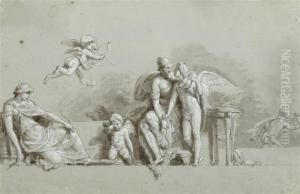Constant Gabriel Vaucher Paintings
Constant Gabriel Vaucher was a Swiss artist whose work spanned the late 19th and early 20th centuries, a period marked by significant transformations in the world of art. Born in 1847 in Switzerland, Vaucher grew up in an era that witnessed the emergence of various art movements, including Impressionism and Post-Impressionism, which would later influence his artistic approach. Despite being less known internationally than some of his contemporaries, Vaucher's contributions to Swiss art during his lifetime were significant, and his works continue to be appreciated by art historians and collectors today.
Vaucher's artistic journey began in his youth, fostered by an environment that valued cultural enrichment and education. He pursued formal art education, which was a common path for artists of his time, seeking to refine his technique and develop his unique artistic voice. His oeuvre includes a range of subjects, from landscapes and portraits to genre scenes, reflecting the versatility of his skills and interests. Vaucher's style evolved over the years, showing influences from various art movements of the time, yet he maintained a distinctive approach that emphasized the interplay of light and color.
Throughout his career, Vaucher participated in numerous exhibitions, both in Switzerland and abroad, gaining recognition and awards for his work. His paintings were appreciated for their depth, sensitivity, and ability to capture the essence of his subjects. Despite the changing art trends over the decades, Vaucher remained true to his vision, blending traditional techniques with new ideas and perspectives.
After his death in 1922, Constant Gabriel Vaucher left behind a legacy that, while perhaps not as widely recognized as some of his peers, continues to be celebrated for its contribution to the Swiss art scene of the late 19th and early 20th centuries. His works are held in various public and private collections, serving as a testament to his skill and artistic sensitivity. Vaucher's life and career offer a fascinating glimpse into the world of Swiss art during a period of great change and innovation, highlighting his role as a bridge between traditional and modernist tendencies.

